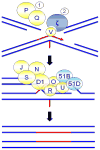Recent discoveries in the molecular pathogenesis of the inherited bone marrow failure syndrome Fanconi anemia
- PMID: 27760710
- PMCID: PMC5391297
- DOI: 10.1016/j.blre.2016.10.002
Recent discoveries in the molecular pathogenesis of the inherited bone marrow failure syndrome Fanconi anemia
Abstract
Fanconi anemia (FA) is a rare autosomal and X-linked genetic disease characterized by congenital abnormalities, progressive bone marrow failure (BMF), and increased cancer risk during early adulthood. The median lifespan for FA patients is approximately 33years. The proteins encoded by the FA genes function together in the FA-BRCA pathway to repair DNA damage and to maintain genome stability. Within the past two years, five new FA genes have been identified-RAD51/FANCR, BRCA1/FANCS, UBE2T/FANCT, XRCC2/FANCU, and REV7/FANCV-bringing the total number of disease-causing genes to 21. This review summarizes the discovery of these new FA genes and describes how these proteins integrate into the FA-BRCA pathway to maintain genome stability and critically prevent early-onset BMF and cancer.
Keywords: DNA repair; Fanconi anemia; Genome instability; Homologous recombination; Ubiquitin.
Copyright © 2016 Elsevier Ltd. All rights reserved.
Conflict of interest statement
There are no conflicts of interest to declare.
Figures


References
-
- Lobitz S, Velleuer E. Guido Fanconi (1892–1979): a jack of all trades. Nat Rev Cancer. 2006;6:893–8. - PubMed
-
- Fanconi G. Familiare, infantile, perniziosaartige Anamie (pernizioses Blutbild und Konstitution) Jahrbuch fur Kinderheilkunde. 1927;117:257–80.
-
- Fanconi Anemia Research Fund, Inc. Fanconi Anemia: Guidelines for Diagnosis and Management. 2014:1–429.
Publication types
MeSH terms
Substances
Grants and funding
LinkOut - more resources
Full Text Sources
Other Literature Sources
Molecular Biology Databases
Research Materials
Miscellaneous

